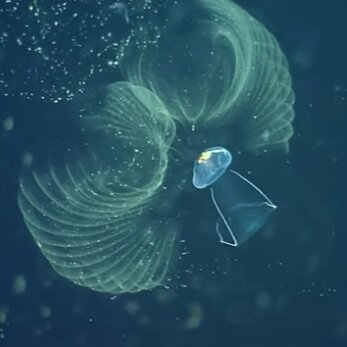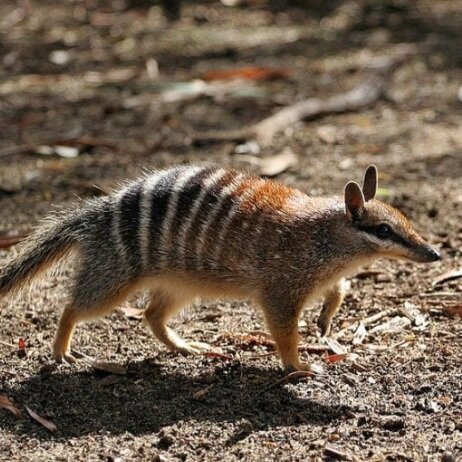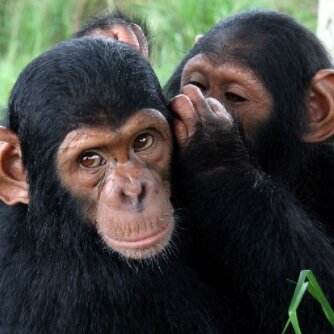Biology to Design (B2D) Project
Kelsey Nelsen | Assignment 5.1 | 10.2.2021
Introduction
The Biomimicry Design Spiral
Image Source: The Biomimicry Institute
The Biomimicry Design Spiral is a tool that is used to create nature-inspired design. The tool encompasses the following steps:
Discover - observe, explore, experience
Abstract - reverse-engineer an organism, articulate the strategy, notice patterns
Brainstorm - identify who needs to perform the function or faces the challenge, consider other functions and uses for the strategy
Emulate - diverge then converge, dive deeper into research and literature, be sure to capture the function
Evaluate - compare your design against Life’s Principles, how could it be adapted further?
Biology to Design - Part 1: Giant Larvacean
The Giant Larvacean is a tiny creature calling the middle-depths of the ocean home. These minuscule invertebrates not only create their own home, but they also filter water and trap carbon. (Asknature.org)
Session 1
DISCOVER
Function/Strategy: These larvae build a structural “home” made of their own mucus to provide a barrier for protection, while also capturing food.
ABSTRACT
Mucus protects
Mucus can grow extremely large in comparison to the small creature
Entire mucus homes are discarded and “rebuilt” as often as once per day
BRAINSTORM
All living things need protection
A “home” in the form of shelter and safety is one of the basic needs as described by Maslow
All living organisms are made of water
Feedback loops are important in life cycles
EMULATE
A protective layer can be applied to fibers to ensure they maintain their structural integrity and prevent microfiber shedding. This would need to be done with water-based chemistry in order for it to align with Life’s Principles. How can this be achieved without the “home” becoming destructed within the wash cycle. Could these garments be “washed” another way?
EVALUATE
Many fiber-coatings are made from other synthetic, chemically-derived materials, thus working against Life’s Principles.
Session 2
DISCOVER
Function/Strategy: The “home” for the Giant Larvacean also functions as a filter for its food.
ABSTRACT
Mucus filters
Made using transparent structural proteins + cellulose
Located within the “house”
Water flows through two entrances and is filtered upon entry
Giant Larvacean uses its tail to pump water and food through the “garbage chute” or into its mouth for consumption
Water is the facilitator
BRAINSTORM
All living organisms are made of water
Filters are necessary to both protect and aid in delivery of nutrients
Water often facilitates these needs
Feedback loops are important in life cycles
EMULATE
Filters can be used in the process of apparel production to ensure microplastics/microfibers are not released into our waterways. A water-based process or reaction could take place at the fiber production level. These fibers would shed from apparel and convert the microfibers into a layer of mucus (or something else) that could be discarded. This would need to occur before fibers are used to create a garment.
At the consumer level, this could be incorporated to a wash cycle and like the lint collector in the dryer the fibers can be collected at the wash level instead.
EVALUATE
As this design would be targeted to synthetic fibers it merely would put a bandaid on a larger issue. Where else could a filter be applied? Recycled poly-fiber production?
Session 3
DISCOVER
Function/Strategy: The size and shape of the filter allow it to move larger bits out of the Giant Larvacean “house” first, only allowing appropriately sized food through to its mouth for consumption. This pathway is facilitated by water.
ABSTRACT
Water facilitates food
Giant Larvacean uses its tail to pump water and food through the “garbage chute” or into its mouth for consumption
Varying size of the filter parts dictates the size of particles allowed to pass through
Microplastics may be released in quantities as great as .7g and 1.3g per wash cycle.
BRAINSTORM
The shape of a filter can dictate what is allowed to pass through
What are the common shapes of microplastic pollution? A filter in a wash cycle could contain large to small sized fibers
EMULATE
Water is readily available and abundant, however the source of the issue (microplastic pollution) lies within it.
EVALUATE
Cyclical processes: It can be cleaned and reused often.
Leverage interdependence: Prevents microplastics from entering waterways. Compatible with many existing washing machines.
Biology to Design - Part 2: Numbat
The Numbat is a marsupial native to Australia, however it differs from many of the marsupials we are most familiar with (kangaroos, etc.). Numbats do not have pouches (their babies cling to them like koalas until they are large enough to move on their own) and while most marsupials are nocturnal, numbats are more often active in the daytime due to their diet (termites)!
Session 1
DISCOVER
Function/Strategy: Utilizing piloerection can aid in maintaining homeostatic conditions.
ABSTRACT
Use of piloerection to trap body-heated air close to the surface of he skin
Provides insulation
Regulates heat absorption and dispersal
BRAINSTORM
Piloerection inspires movable hairlike systems to optimize heat regulation for changing conditions
Temperature, wind, humidity, sunlight
Maintaining equilibrium in clothing optimizes comfort
EMULATE
Like wearing a coat of goosebumps, textiles can be innovated to arrange fibers to optimize thermoregulation and provide a specific solution to a common need (maintained warmth & comfort across conditions). I could see this adapting to a fiber that responded to temperature - the fibers stand on end in cold temperatures and lay flat in the warmth.
EVALUATE
In order for this option to truly be successful, it would need to be derived from natural fibers, thus aligning with Life’s Principles:
Locally attuned & responsive
Resilient
Session 2
DISCOVER
Function/Strategy: Thin pelts allow numbats to absorb more solar heat while reducing heat lost when they erect their pelts.
ABSTRACT
Numbats do not create enough fuel from termites alone, the must also regulate their body head with the sun.
Numbats have sparse coats
Maximizing solar radiation
BRAINSTORM
Incorporate reflective materials in the fibers to optimize the solar absorption
Maintaining equilibrium in clothing optimizes comfort
EMULATE
The fibers or textiles themselves could be made to have minimal reflective properties and a base that utilizes ample solar heat while maintaining a balanced flow of energy.
EVALUATE
Optimize vs. maximize
Benign manufacturing
Biology to Design - Part 3: Chimpanzees
Session 1
DISCOVER
Function/Strategy: Adult chimpanzees teach the use of tools to their young, leading by example, and encouraging the use of more complex aids for termite-hunting (adapted to new sustainable consumer behavior)
ABSTRACT
Adults influencing the young / young influencing adults
Sharing lessons
Building skills
Mimicking behavior
BRAINSTORM
Factual information must be accessible for all people, no matter age, race, socioeconomic status, location, etc.
Specifiers providing transparency in product features
Data to be shared globally for material specifications so consumers know what they are purchasing
People are educated, then share the information with their young
EMULATE
I could see this as a resource/database maintained for easily understood data classifications for garments. A consumer purchases a garment, can scan a code (on the label), and much like the nutritional facts on food, it populates a list of the fiber content, manufacturing location, and all other relevant data about it’s production so that the consumer knows exactly what they are getting.
EVALUATE
Interdependence in the System
Session 2
DISCOVER
Function/Strategy: Different lessons across and within communities can encourage diversity of thought and enrichment when shared.
ABSTRACT
Behavioral differences across communities
Diversity
Differing methods of teaching
Simple
Complex
Lesson types
Gestures
Vocalization
Visual
Leading by Example
BRAINSTORM
Knowlege-sharing is key to finding efficiencies
Community building
EMULATE
Encouraging thought partners can strengthen community, celebrate diversity of thought, and lead to deeper relationships.
EVALUATE
Locally Attuned and Responsive
Session 3
DISCOVER
Function/Strategy: Communicating messages in a variety of ways allows a broader reach.
ABSTRACT
Lesson types
Gestures
Vocalization
Visual
Leading by Example
BRAINSTORM
Lessons in proper garment care, repair, upcycling
Marketing that drives thoughtful consumption
Encourage locality / domestic manufacturing
Emanate the environment for more beautiful content
EMULATE
Put environment first, think about the content, lead all messaging with kindness/hope/health/life. Positivity is inspiring. Teach resourcefulness. Encourage reuse, encourage connection, make it experiential.
EVALUATE
Locally Attuned and Responsive
Cyclical Process
Resilient
Optimize vs. Maximize
Interdependence in the System






